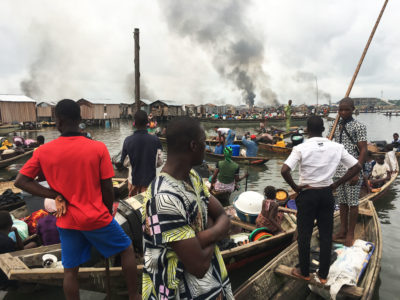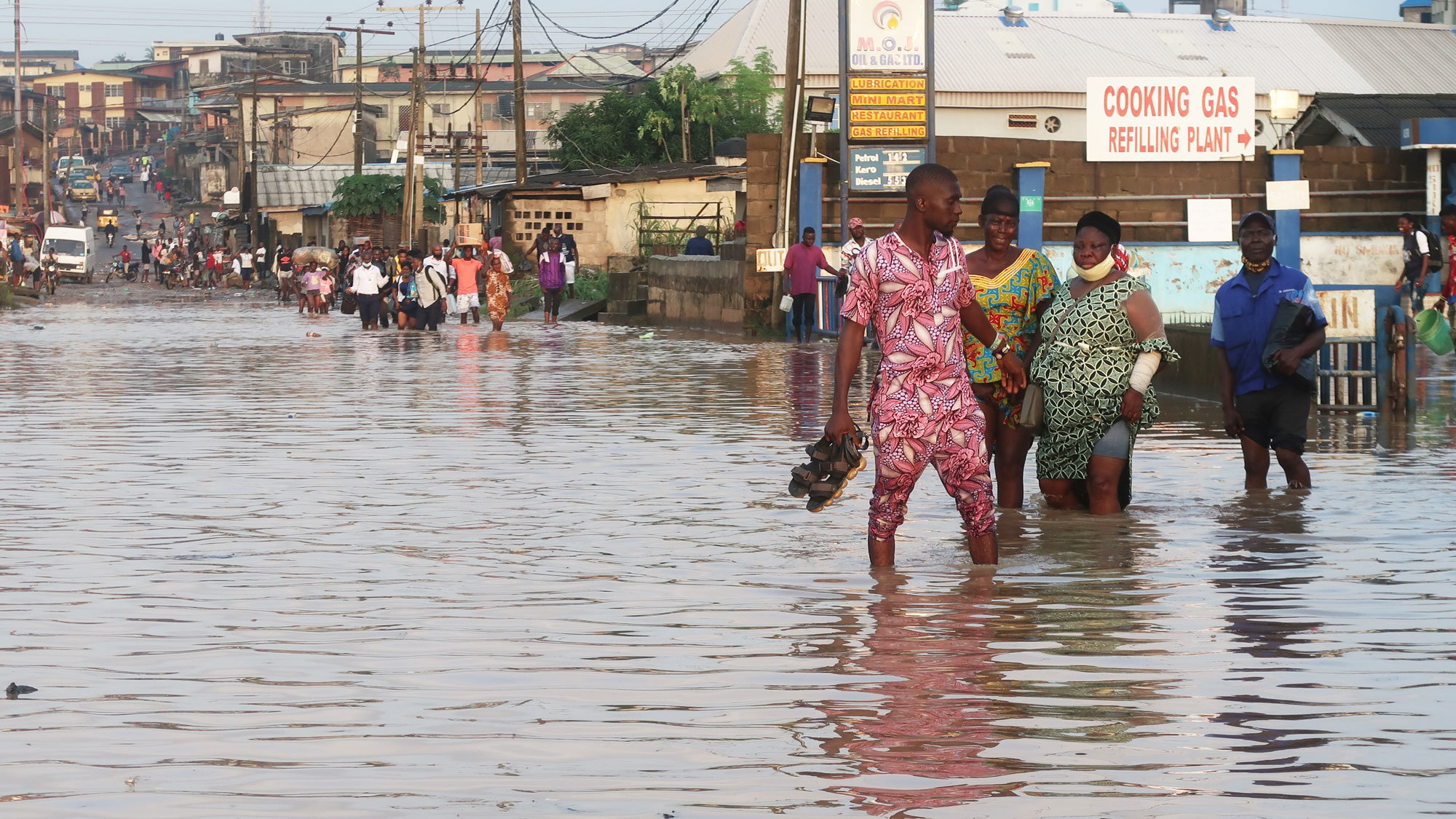As seas rise and coastal storms intensify, policymakers and low-lying cities across the globe are more and more wrestling with the fact of needing to relocate whole communities to increased, safer floor. Scientists estimate that as much as 340 million individuals in coastal areas could possibly be displaced by 2050, and 630 million by 2100, in places from the USA to Nigeria to the Philippines.
Such widespread, organized retreat from the shore will take huge quantities of planning and funding, however geographer Jola Ajibade warns it additionally must be performed in an equitable approach. For that to occur, she says, policymakers should take into accounts the numerous cultural, financial, and racial justice impacts on the communities being uprooted.

Jola Ajibade
In an interview with Yale Surroundings 360, Ajibade, an assistant professor at Portland State College who research the politics of local weather change adaptation and resilience planning within the World South, talks about how managed retreat applications have to differ in several elements of the globe; what number of of those applications unfairly goal low-income communities and communities of colour; and what relocation plans truly should be equitable and profitable.
“How will we transfer individuals away from locations of threat,” she says, “with out stripping them of their id, company, tradition, and certainly, livelihood?”
Yale Surroundings 360: You grew up in Lagos, Nigeria, one among world’s most at-risk main cities from sea degree rise. Did you expertise flooding throughout your childhood?
Jola Ajibade: I grew up in Lagos in an space that usually ought to have been a swampland. It shouldn’t have been a spot the place individuals would construct homes. However as you already know, like most cities on this planet, with urbanization there was simply this enlargement of buildings and buildings everywhere.
The place I grew up, it’s referred to as Ijeshatedo. We didn’t know something about local weather change again then; I simply observed that, as a baby, it flooded on a regular basis. We have been residing on the primary ground of a constructing and it was flooded nearly each time it rained. Once I would ask my mother, “Why?,” she would inform me, in Yoruba, “They shouldn’t have constructed on this place. That is swampland.” Now that I’m engaged on points round local weather change and adaptation, I’m realizing that, certainly, what my mother stated on the time was proper. There are areas across the coast, there are areas in sure cities, the place it ought to have simply been left to nature.
However I’ve observed that the flooding in Lagos within the final 10 years or extra, it isn’t remoted anymore. Once I was younger, it was remoted to these swampy areas, together with the place I lived. However now it’s all over the place. It occurs within the rich areas of the town as properly. In order that’s one factor that has modified. It’s now not solely the poor being impacted. It’s everybody.
“New properties are being constructed for the rich alongside the coast, whereas the poor are being moved away from it.”
e360: A lot of your analysis focus has been on managed retreat within the World South. How does retreat differ between that area and in additional developed nations, like the USA or Europe?
Ajibade: There are such a lot of variations. I’ll begin with one which I don’t suppose is suitable — what occurred in Lagos in 2017, the place about 30,000 individuals residing in [the informal fishing settlement] Otodo-Gbame have been forcefully kicked out. I don’t name {that a} buyout. They have been actually kicked out by the federal government. There was this coverage, the Lagos Local weather Change Coverage, that stated, “We’re going to relocate and resettle individuals and infrastructure and business.” However the actuality of who has been relocated and who has been moved, it was simply the poor. And so they weren’t given any help, not even given a spot to relocate to. In order that was very problematic the way in which that occurred.
In Manila, there are three several types of managed retreat. After Ondoy in 2009, the large tropical storm the place greater than 850 individuals died and about 7 million individuals have been affected in the entire of the Philippines, the federal government put in place a plan to relocate the poor as a result of, they stated, they’re a part of the rationale why the town obtained flooded. One of many first issues they did was to right away give a number of units of individuals in sure slum areas cash to relocate. In 2013, they institutionalized a program referred to as the Oplan LIKAS Program, wherein they spent 50 billion pesos [$1 million] to construct new homes within the outskirts of the town after which relocate 100,000 individuals.
The problem is that after they completed constructing… lots of the buildings weren’t correctly constructed. They gave individuals like 18,000 pesos [$373] and stated, “Okay that is the cash, don’t take any of this stuff out of your slum, they’re going to mess up that place you’re going. Simply take your bag and garments and go.” So individuals did and after they obtained there they discovered that the homes have been only a shell, only a construction, it was actually nothing else. In some locations, they didn’t have electrical energy, individuals didn’t have types of livelihood, that they had no social companies, that they had no well being care, that they had no faculties.

Youngsters close to their houses on Manila Bay within the Philippines, the place authorities have been relocating individuals from coastal slums.
Jes Aznar/Getty Pictures
The opposite drawback was that a few of the new locations additionally obtained flooded. It wasn’t like they have been freed from flooding. I’d say retreat in Manila was the way in which to decongest the town. It wasn’t nearly defending individuals.
Alternatively, whereas that was occurring, there was this place referred to as New Clark Metropolis that the federal government was planning to relocate the political class to. Principally, individuals who work within the administrative workplaces within the authorities in Davao Metropolis and Manila Metropolis. In New Clark Metropolis, railways have been constructed, there’s even a sport heart. The query is, if they’ll try this, why couldn’t they do the identical factor for the poor individuals?
e360: You’ve used the phrase, “the retreat and return cycle.” What does that imply, and is that what occurred in Manila?
Ajibade: Sure. Individuals retreated. They have been like, “High-quality, we’ll go.” However then they obtained there they usually have been shocked about what they discovered they usually stated, “No, we’re going again.” And so the retreat and return, for my part, was the poor’s approach of resisting, it was their approach of exhibiting their very own company — we agreed to one thing, if [the government is] not going to uphold its finish of the discount, then we’re going to withstand that kind of relocation that doesn’t actually advance our lives, that doesn’t make our life any higher. Most of the people who find themselves residing within the Manila slums are literally migrants, usually individuals who depart rural areas on the lookout for alternatives after which they arrive to the town. You don’t need to transfer them again to areas the place they don’t have something once more.
e360: There’s a lengthy historical past of unjust relocation applications, significantly amongst Indigenous or low-income communities or communities of colour. How do you get such teams, that may balk on the thought of government-led managed retreat due to that historical past, to signal on now, within the face of local weather change?
Ajibade: It is a robust query. One in every of my colleagues, A.R. Siders, has argued that in North Carolina, retreat appears to be targeted in locations the place you have got low-income communities of colour. With my international analysis, I see the identical factor. Retreat is the truth is occurring to the poor; we’re seeing injustice being bolstered by way of retreats. New properties are being constructed for the rich alongside the coast, whereas the poor are being moved away from it.
“In forfeiting the land that you just really feel very tied to, it says one thing about shedding part of your id.”
We’d like particular tips, we’d like particular establishments and constant coverage, on methods to retreat and who ought to retreat and when. And likewise who ought to be on the desk discussing retreat. [Decisions are being made] to seek out methods to maintain individuals on the coast, however it’s principally in locations that might keep the wealth of sure teams of individuals. On this case [the U.S.], usually white individuals, within the World South, usually rich individuals. If we don’t have insurance policies and tips which can be equitable, we’re prone to see a repeat of what one might take into consideration as a unique type of colonialism — local weather colonialism. We have to look rigorously on the image of who that is occurring to. Who’s shedding the generational wealth that they may have had however now have misplaced as a result of they’ve been requested to maneuver?
e360: What concerning the cultural implications or loss related to such relocation applications?
Ajibade: Precisely. How will we transfer individuals away from locations of threat with out stripping them of their id, company, tradition, and certainly livelihood? With retreat, we may even see one household get a buyout, however one other doesn’t or they don’t settle for it. These communities lose their very own tradition piecemeal-fashion.
Within the case of Isle de Charles, in Louisiana, the truth that the neighborhood has agreed to maneuver as a complete, as one unit, to increased floor, I believe is an effective factor. However what’s difficult is that additionally they are saying, “we nonetheless need to have the ability to keep this tie to the land that we’re leaving, as a result of regardless that we leaving that land behind, it was a spot that we’ve lived for years, it was a spot that we cherished, it was a spot that had which means to us. And we need to maintain some type of possession.” However the authorities is saying, “No, when you’re taking over this new place within the mainland, then it’s a must to forfeit that.” So in forfeiting the land that you just really feel very tied to, it says one thing about shedding part of your id. That land is an id for them, it’s one thing that issues to them.

Evicted residents of the Otodo Gbame settlement in Lagos, Nigeria watch smoke from houses burned by authorities in 2017.
Justice & Empowerment Initiatives
The opposite a part of that is when individuals transfer, they’re shifting to a neighborhood the place individuals don’t know them. Discovering methods to foster that neighborhood constructing and solidarity between relocating communities and receiving communities is one other factor that we’d like to consider. This is similar problem within the case of Kiribati and Fiji: Kiribati has been in a position to purchase some land in Fiji so it may well relocate its individuals. However there are individuals asking when Kiribatians transfer to Fiji, are they going to be Kiribatians in Fiji or are they taking a brand new Fiji id over the long-term. And do they name themselves Fijians? After which if their nation or if their island state disappears, whenever you then say, “I’m a Kiribatian” however your nation is underneath water, what does that say about your existence?
e360: Is there a spot that’s doing assisted migration the fitting approach? That would function a mannequin for different communities?
Ajibade: Many individuals have requested me this and there’s no good reply. Initially, I assumed Isle de Jean Charles could possibly be a mannequin, however the extra I dug into it, the extra I spotted that there are loads of issues. Even with authorities help and cash, there are nonetheless so many points referring to unequal energy relations in how that is enjoying out.
After we’re serious about what constitutes a profitable retreat, it comes again to what precisely are you speaking about whenever you say “success.” Is it profitable for the people who find themselves relocating? Is it profitable for the communities who’re receiving these individuals? While you obtain individuals into your metropolis or into your neighborhood, you acquire one thing, proper? These communities, they convey not simply their our bodies, they convey the entire abilities and sources they’ve as properly. We simply have to acknowledge that managed retreat is all the time going to have trade-offs.
This interview has been edited for size and readability.
